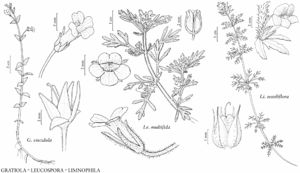Limnophila
Prodr., 442. 1810.
| Taxon | Illustrator ⠉ | |
|---|---|---|
 | Gratiola viscidula Leucospora multifida Limnophila sessiliflora | Barbara Alongi John Myers Barbara Alongi |
Herbs, perennial [annual], paludal or aquatic, emergent. Stems erect [prostrate, creeping], hairy or glabrous. Leaves cauline, opposite or whorled, dimorphic; petiole present or absent; blade not fleshy, not leathery, margins of submerged leaves pinnatifid, of aerial leaves entire, serrate, or pinnatifid. Inflorescences terminal or axillary, racemes or flowers solitary, rarely paired [or spikes]; bracts present or absent. Pedicels present or absent; bracteoles present or absent. Flowers bisexual, chasmogamous or cleistogamous; sepals 5, basally connate, calyx bilaterally symmetric, tubular, lobes triangular or lanceolate [ovate]; corolla blue, blue-purple, or white, bilaterally symmetric, bilabiate, tubular or funnelform, tube base not gibbous or spurred, lobes 4 or 5, abaxial 3, adaxial 1 or 2; stamens 4, basally adnate to corolla, didynamous, filaments glabrous or hairy; staminode 0; ovary 2-locular, placentation axile; stigma capitate, 2-lobed. Fruits capsules, dehiscence septicidal. Seeds 20–200, brown to dark-brown, conic to cylindric, wings absent. × = 17.
Distribution
Introduced; Asia, Africa, Pacific Islands, Australia, also in South America
Discussion
Species 40 (2 in the flora).
The two species recognized here could be difficult to distinguish throughout their ranges; intermediate plants, which are believed to be hybrids, have been found.
Limnophila is closely related to Hydrotriche Zuccarini, a small genus of aquatic plants native to Madagascar. Together they form a group sister to Gratiola in Gratioleae (D. Estes and R. L. Small 2008).
Selected References
Lower Taxa
Key
| 1 | Pedicels 3–8 mm in flower, 5–12 mm in fruit; bracteoles 1–3.5 mm; corolla tubes 4–5(–8) mm; cleistogamous flowers absent. | Limnophila indica |
| 1 | Pedicels 0–2 mm in flower, 0–4 mm in fruit; bracteoles 0–1.5 mm; corolla tubes 8–10 mm; cleistogamous flowers present, submerged. | Limnophila sessiliflora |